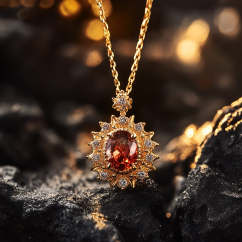Jewelry ECOMM Tech
Mastering Jewelry Photography: Essential Techniques | May 23, 2025 (0 comments)

In this guide, we'll explore essential techniques to help you take stunning photos that highlight the allure of your jewelry pieces.
Setting Up Your Studio
Creating an ideal setting for jewelry photography is crucial. Since jewelry pieces are small and detailed, they require a controlled environment to capture their essence effectively.
Choose the Right Background
A clean and neutral background ensures that the focus remains on the jewelry. Use backgrounds like white or light gray to make the jewelry pop. Avoid busy patterns that can distract the viewer.
Lighting is Key
Lighting plays a pivotal role in jewelry photography. Natural light can work wonders, but if you're shooting indoors, invest in softbox lights or LED panels. These lights provide a steady, diffused glow that reduces harsh reflections and shadows.
Use a Tripod
Stability is crucial when photographing jewelry. A tripod eliminates camera shake and ensures sharp, focused images. It's especially useful when shooting at slower shutter speeds in lower light conditions.
Essential Equipment for Jewelry Photography
While you don't need the most expensive gear to take great photos, certain equipment can enhance the quality of your images.
Camera and Lenses
A DSLR or mirrorless camera with manual settings offers the best control over your shots. Pair it with a macro lens to capture fine details. Macro lenses allow you to get close to the subject, highlighting textures and craftsmanship.
Reflectors and Diffusers
Reflectors help bounce light onto the jewelry, minimizing shadows and enhancing sparkle. Diffusers soften the light, preventing harsh reflections and glare. Both are essential tools in a jewelry photographer's kit.
Polarizing Filters
Consider using a polarizing filter to reduce reflections on shiny surfaces. It can help bring out the true colors and intricate details of gemstones and metals.
Composition and Styling Tips
The way you compose and style your jewelry photos can greatly affect their visual appeal.
Focus on Details
Jewelry often features intricate designs that deserve attention. Use your macro lens to zoom in on specific elements, such as the cut of a gemstone or the intricacy of a setting.
Experiment with Angles
Don't be afraid to try different angles. Sometimes, shooting from a lower or higher perspective can reveal unexpected beauty in a piece. Experimentation is key to finding the most flattering angles.
Incorporate Props
Props can add context and interest to your shots. Consider using complementary items like flowers, fabrics, or stones. However, ensure they don't overshadow the jewelry itself.
Post-Processing for Jewelry Photography
Editing is a crucial step in jewelry photography. It allows you to enhance colors, correct exposure, and remove any imperfections.
Basic Adjustments
Start with basic adjustments like cropping, straightening, and correcting exposure. These simple tweaks can vastly improve the composition and balance of your photos.
Enhance Colors and Clarity
Jewelry should sparkle in your photos as it does in real life. Enhance the colors slightly to make gemstones pop. Use clarity adjustments to bring out the fine details without over-sharpening.
Retouch Imperfections
Remove dust, scratches, or fingerprints that may be visible on the jewelry. Most editing software offers tools for retouching these small imperfections.
Common Challenges and Solutions
Jewelry photography comes with its own set of challenges. Here are some common issues and how to overcome them.
Dealing with Reflections
Reflections can be distracting in jewelry photography. Position your lights strategically to minimize them. Using a polarizing filter can also help control unwanted reflections.
Capturing True Colors
Sometimes, the colors in your photos may not match the real-life hues. Adjust the white balance on your camera or in post-processing to ensure accurate color representation.
Ensuring Sharp Focus
Small apertures (higher f-stop numbers) increase depth of field, ensuring that more of the jewelry is in focus. If you're struggling with focus, try focus stacking techniques in post-processing.
Practical Jewelry Photography Tips
Here are some additional tips to improve your jewelry photography skills:
Clean Your Jewelry: Dust and smudges are more noticeable in close-up shots. Ensure your pieces are clean before photographing.
Mind the Reflections: Check your surroundings for unwanted reflections, including yourself!
Keep It Simple: Let the jewelry speak for itself. Avoid cluttered compositions that detract from the piece.
Conclusion
Mastering jewelry photography is a journey of experimentation and discovery. By setting up the right environment, using the appropriate equipment, and honing your composition and editing skills, you can create stunning images that do justice to the beauty of your jewelry. Keep practicing, stay patient, and let your creativity shine through each photograph.
About The Author:
Mike Hauben is the Creative Director for the Centurion Jewelry Show. He has over twenty years experience and holds a number of digital certifications (Google, Yoast, Hubspot, and more). Mike has gained recognition among the jewelry industry in recent years as a popular keynote speaker, author, and trusted expert.
Learn more: haubenmedia.com


